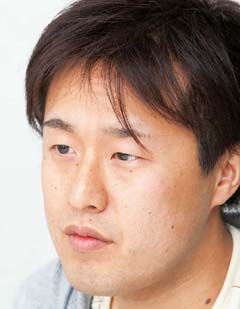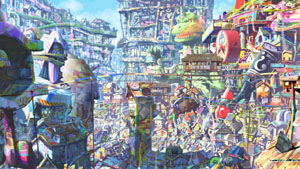Interview with Naoyoshi Shiotani (2)
 | Naoyoshi Shiotani Born in 1977, Shiotani is one of Japan's most promising young animation creators. His early works include TV series Windy Tales (key animation supervisor, 2004) and Blood+ (2005), for which he also directed the kaleidoscopic third opening film, Colors of the Heart (check our special feature here), selected in competition for the 11th Holland Animation Film Festival. His directorial debut, Tokyo Marble Chocolate (2007) was awarded with the Grand Prize in the Feature Films Section of SICAF 2008. Shiotani joined the staff of Production I.G's first 3DCG animated feature film, Oblivion Island: Haruka and the Magic Mirror as storyboard artist an animation director, but also contributed the island design concept and designed Cotton, the sheep-shaped plush doll that belongs to the protagonist, Haruka. |
PART 2
How did you get involved in Oblivion Island?
The movie's producer called me when I was completing Tokyo Marble Chocolate. Then I was introduced to the director, Shinsuke Sato, who told me that he wanted to make a movie that children would never forget. I was touched by those words, and as I agreed with his vision, I accepted to join in. When I read the script for the first time, I was immediately moved by the story setting and the whole theme of the movie. All those little treasures that humans carelessly leave lying around are being in fact brought into a different world by fairy-like creatures and used to build a whole city. It was an enthralling concept with infinite potentials.
In the movie you are credited as "animation director." What does an animation director do exactly?
Shinsuke Sato is coming from live-action filmmaking, so my role was to adapt and expand his ideas into the animation medium and to supervise the animation team, as the movie director may not necessarily be in the studio all the time. I joined the production when the script was almost completed, so the first step was to share with Sato-san our mutual visions. We had long brainstorming sessions in order to be sure that I would proceed in the direction he envisioned, and that he agreed on what I had in mind to put into the movie myself. We exchanged our ideas on everything. How to make the story more gripping and compelling? How should the characters look like? What should the island be like? And so on.
For instance, I have added most of the action scenes you can see in the second half of the movie, and I gave more space to Cotton, Haruka's stuffed animal, that I designed myself.
Most of all, I convinced Sato-san to add the scene when Haruka and Teo watch the memories inside the mirror. When I saw the final result, I was glad I'd been so persistent.
After all these modifications, I drew the storyboard, a tool that can be described as the movie's blueprint. From that point, I had meetings with each section of the production team. We decided the lighting and camera angle for each scene, how the characters were supposed to move, the visual effects, the colours and so on.

So you had a creative part both in the story and the artistic part of the production, right?
I guess you can say so. I also made rough concept designs for the island, as I wanted it to fit with the story concept. I studied hundreds of pictures of various buildings and castles from all over the world, and I was strongly inspired by Japanese artist Shusaku Arakawa. I visited his Site of Reversible Destiny - Yoro Park in Gifu Prefecture, an amazing place were absolutely ordinary objects are disposed in an absolutely un-ordinary fashion within an environment that has no straight lines or plain surfaces. I imagined that the island inhabitants used objects conceived in the human world to build things according to their sensitiveness, in a quite original interpretation of what they saw in the place they took them. And since the island conceptual design was fundamental to this project, I was determined to keep the same style and atmosphere in each scene and detail. However, this ended up with me drawing the background art boards for about 1000 scenes. The background art boards are the reference drawings used by the background artists. When everybody in the studio left, I was still at my desk drawing, sometimes till the next morning...
The island landscape is an amazingly detailed kaleidoscope of objects of all kind. Did you help decide what should be included?
I wanted people of any generation to feel nostalgic about what they saw on the island, so we used many object from very different periods. As a first step, we asked the staff to gather all kind of old toys, electric appliances, cars, cans, bottles, flyers, books and magazines. Then we selected those we thought could work to build the island landscape. There are so many objects in any background, that one may just spend weeks trying to locate all of them!
(2 - to be continued)
© 2009 FUJI TELEVISION NETWORK / Production I.G / DENTSU / PONY CANYON

![WORK LIST[DETAILS]](/contents/works/design/images/left_title.gif)



 terms of use
terms of use